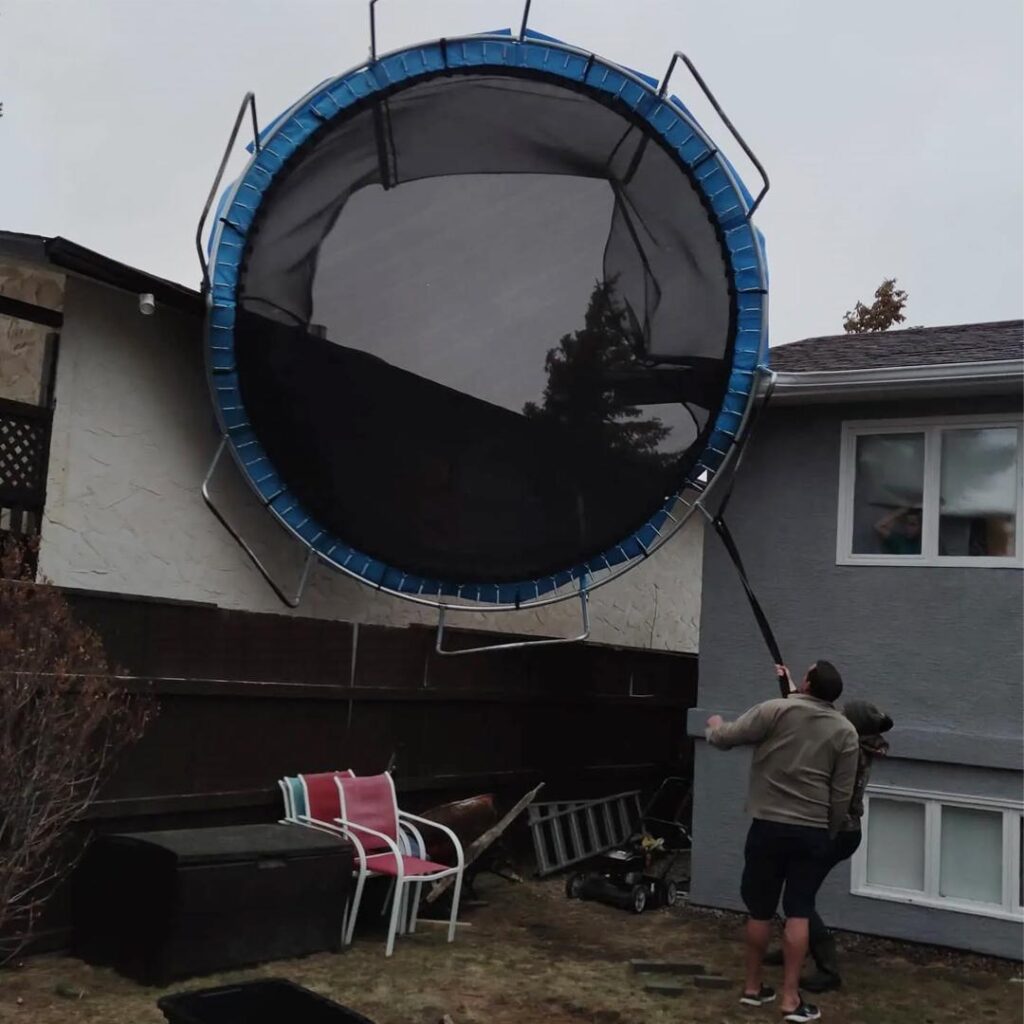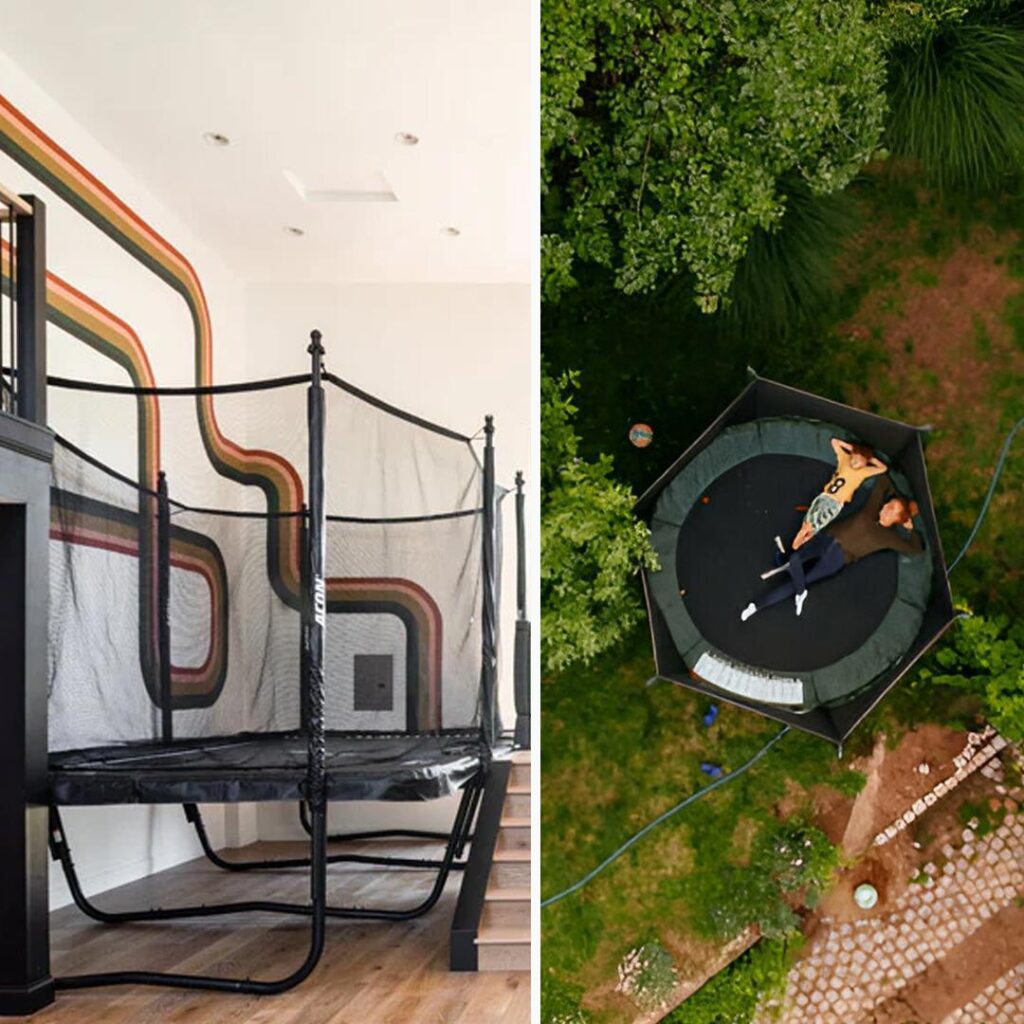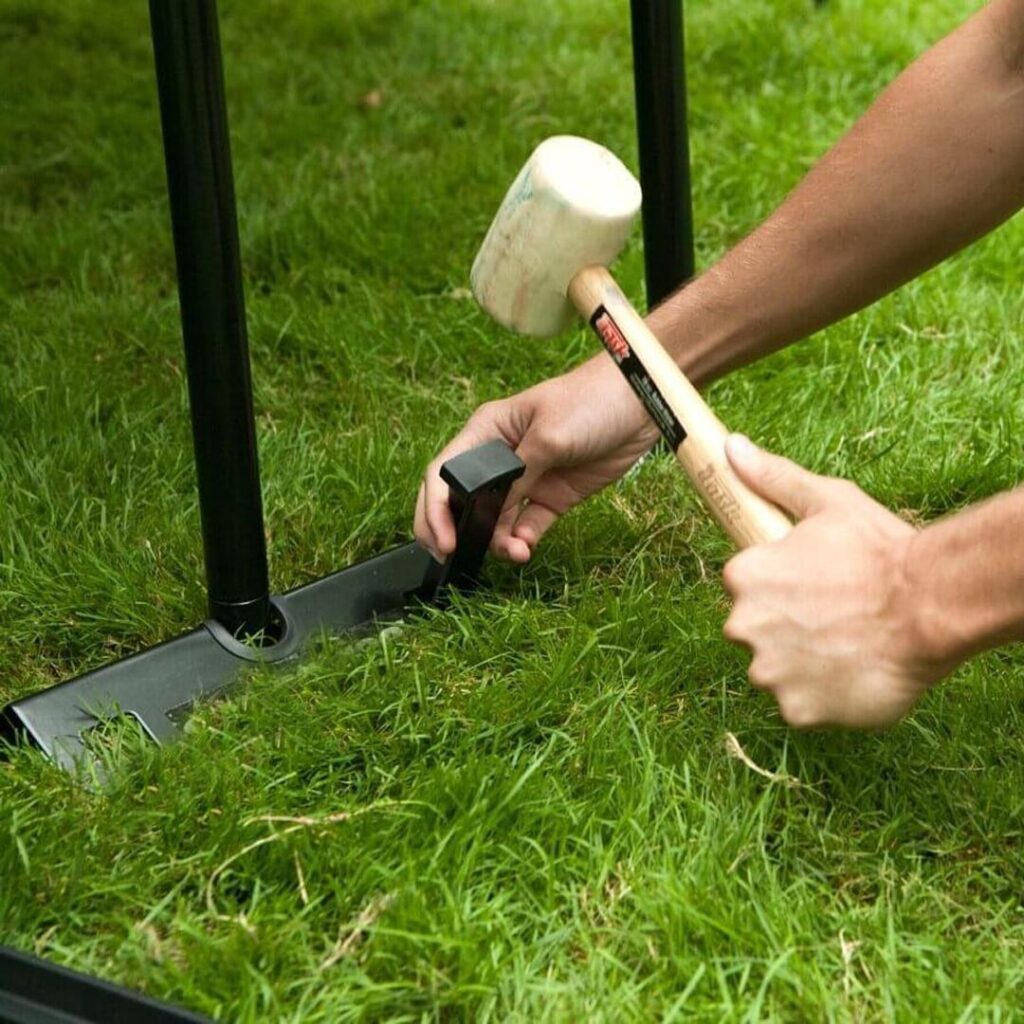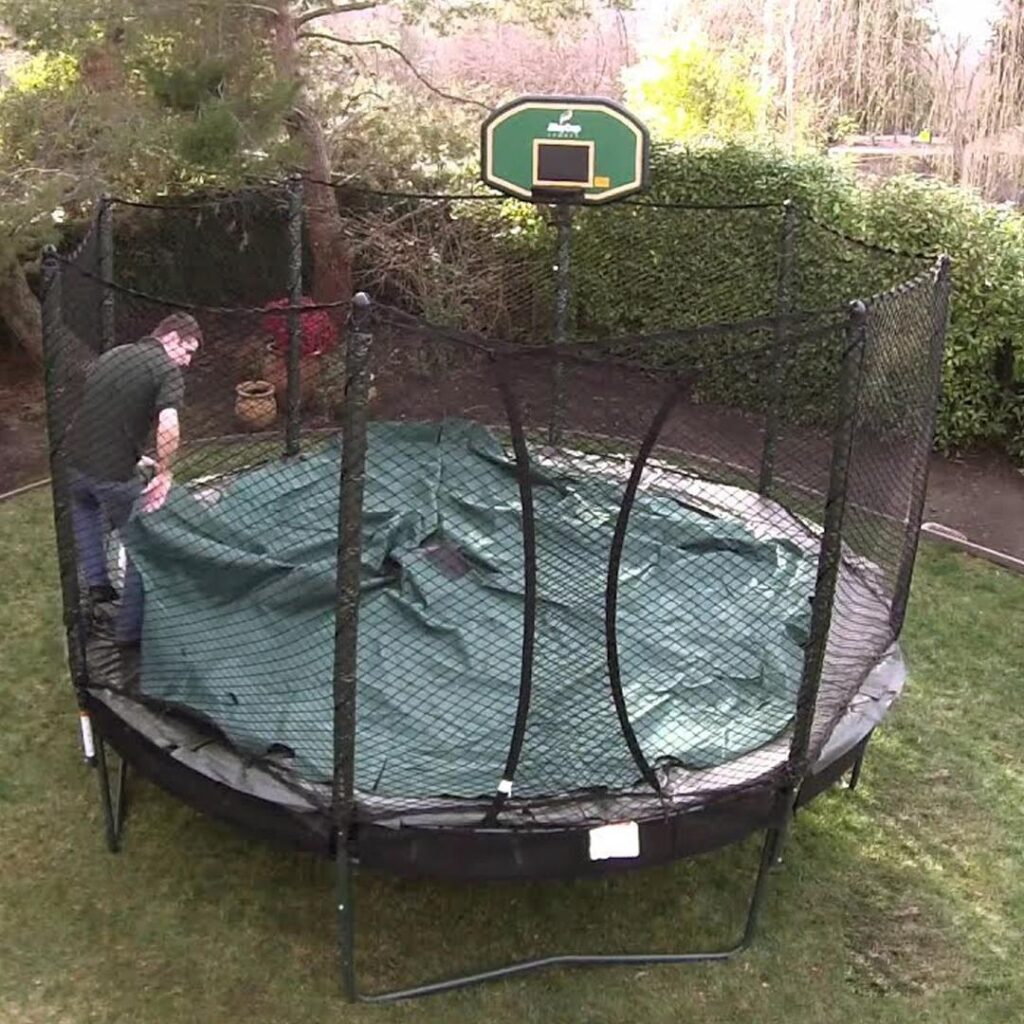What if your trampoline takes off during a storm, turning from a safe garden pastime to a potentially fatal flying threat? Safeguarding your family, your home, and even your neighbours is more important when it comes to trampoline security than just the equipment itself. When winds are strong, an unattended trampoline can turn into a dangerous missile that can endanger people, animals, cars, and structures. To avoid mishaps and guarantee comfort, it’s essential to comprehend and employ appropriate safety measures.
Through this guide we would like to provide you all the information you need to keep your trampoline safe from blowing away. We’ll go over every crucial step to maintain your trampoline safe, from picking the ideal spot and utilising the best anchoring methods to doing routine maintenance. Transform your trampoline into a positive energy powerhouse – one that not only absorbs the winds of change but rebounds with even greater resilience.”

Understanding the Risks
Potential Dangers of a Trampoline Blowing Away: Although it may sound theatrical to picture a trampoline being blown around by heavy winds, the repercussions are often dire and very real. A trampoline that gets airborne turns into a massive, heavy projectile that can seriously injure people and inflict a great deal of property damage.
Common Weather Conditions That Cause Trampolines to Become Airborne

It is essential to comprehend the weather patterns that can cause these dangerous circumstances. Particularly at risk are trampolines during:
- Storms: If an above or in-ground trampoline is not securely fastened, it can be easily lifted by strong winds and heavy rain. Storm-related gusts can be strong enough to transform a trampoline into a missile.
- High Winds: There might be severe wind gusts even on a sunny day. A trampoline can begin to move at wind speeds of more than 20 mph, and at much higher rates, it can be lifted entirely off the ground.
- Hurricanes: Extreme winds from these strong storms can easily toss a trampoline about, posing serious risks to anything in their path.
Understanding the circumstances that can turn your trampoline into a risk will help you secure it properly and prevent accidents from happening, keeping your garden an enjoyable and safe place to be.
Choosing the Right Location
Importance of Placing the Trampoline in a Sheltered Area
Your first line of defence against your trampoline blowing away is to choose a good place for it. Your bespoke trampoline will be far less exposed to the wind and less prone to take off if you place it in a protected spot. The best places are those near structures, fences, or naturally occurring windbreaks, such as hedges and trees, which can act as a buffer against severe gusts.
Factors to Consider When Selecting a Location
When deciding where to place your trampoline, consider the following factors:
- Wind Direction: Observe which way the wind is blowing in your neighbourhood. To reduce risk, place your trampoline on the side of the home that is shielded from the wind.
- Proximity to Trees and Buildings: These constructions have the potential to serve as windbreaks. Extra safety can be obtained by positioning your trampoline close to a strong wall, fence, or stand of trees.
- Landscape Features: Make the most of your yard’s natural contours. Additional cover can be provided, for instance, by positioning the trampoline behind a sturdy hedge or on the leeward side of a small hill.

Avoiding Open and Exposed Areas
Certain areas are particularly risky for any types of trampoline, whether for performance, fitness or commercial use due to their exposure to wind. Avoid placing your trampoline in:
- Hilltops: Elevated areas are more susceptible to wind, making hilltops a dangerous choice.
- Open Fields: Wide, open spaces allow the wind to gather speed and strength, increasing the risk of your trampoline being lifted.
If you have no choice but to place your trampoline in a more open area, consider these tips to create a more sheltered environment:
- Build a Windbreak: Erect a fence or plant a row of hedges to act as a barrier against the wind.
- Use Portable Barriers: Set up temporary windbreaks such as screens or tarps during particularly windy conditions.
By carefully selecting and modifying the location for your trampoline, you can greatly reduce the risk of it being blown away, ensuring a safer play environment for everyone.
Securing the Trampoline with Anchors
Types of Garden Trampoline Anchors Available
Trampoline anchors come in various styles, each offering different levels of stability. Here are the most common types:
Auger-style Anchors: These anchors screw into the earth and have a shape resembling a corkscrew. They offer exceptional stability and are robust, particularly in softer soil. Nevertheless, compared to other types, they could take more work to install.
- Advantages: Exceptional stability, appropriate for loose soil.
- Cons: Installation takes work.
U-shaped Anchors: These U-shaped anchors are usually composed of heavy-duty steel. They stably anchor the trampoline legs and are driven into the ground at an angle. U-shaped anchors provide high stability in a variety of soil types and are simple to install.
- Pros: Strong stability and ease of installation.
- Cons: In very soft or rocky soil, it might not be as effective.
Spiral Anchors: The helical shape of spiral anchors spirals into the earth. They work well with a variety of soil conditions and are adaptable. Spiral anchors are a popular option among users since they are simple to install and offer the trampoline excellent stability.
- Positives: Strong support, adaptable, and simple to install.
- Cons: Twisting into hard soil could take a little more work.
Product recommendation: Trampoline Tie Down Ground Anchor Kit
Step-by-Step Guide on How to Install Trampoline Anchors

Installing trampoline anchors is a straightforward process. To ensure a safe setup, adhere to following steps:
- Gather Your Tools: A mallet or hammer, the right trampoline anchors, and sometimes a drill for more durable soil are required.
- Position the Anchors: Make sure the trampoline is level before placing it over the appropriate spot. Align the anchors with the legs and place them at equal intervals around the perimeter of the trampoline.
- Drive the Anchors into the Ground: Each anchor should be forcefully driven into the ground with a mallet or hammer until the top loop or eyelet is the only part that is visible above the surface. Use a twisting motion to tuck spiral anchors into the ground.
- Attach the Trampoline Legs: After the anchors are in place, proceed as normal to fasten the trampoline legs to the frame.
- Secure the Trampoline: After assembling the trampoline, fasten the included chains or straps to the anchor eyelets on the trampoline legs. Verify that the straps are secured tightly.
You can make sure that your trampoline is securely set up, resistant to wind, and safe for everyone to jump on by following these instructions and using the right anchors.
Tips for Ensuring Anchors Are Securely Placed
Maintaining a safe and secure setup requires routinely checking the stability of your trampoline anchors once you’ve installed them. The following advice will help you make sure your anchors stay securely in place:
Check the Stability of Anchors
- Visual Inspection: Make sure the anchors are still securely buried in the ground by visually inspecting them regularly. Seek indications of any shifting or movement.
- Tug Test: To ensure each anchor is stable, give it a light tug. An anchor may need to be adjusted or strengthened if it moves or feels flimsy.
- Rock Test: Attempt to gently rock the trampoline back and forth. They are probably secure if the trampoline stays steady and the anchors hold firmly. If there is any movement, though, it can mean that the anchors need to be adjusted.
Routine Checks:
- Regular Inspections: Plan regular trampoline anchor inspections, particularly following inclement weather like storms or strong winds. Look for indications of loosening or damage.
- Seasonal Maintenance: Make sure the anchors are still firmly in place by doing extensive inspections at the start and conclusion of every season. As soil conditions or weather patterns change, make necessary adjustments or reinforcements.
- Tighten as Necessary: Tighten the anchors right away to stop any further movement if you see that they are becoming progressively looser. If required, pound them deeper into the ground using a hammer or mallet.
- Replace Damaged Anchors: To preserve the integrity of the anchoring system on your trampoline, replace any anchors that exhibit wear or damage, such as bending or rusting.
You can make sure that your trampoline anchors stay firmly in place and offer a secure jumping and playing surface by heeding these guidelines and adding routine inspections to your maintenance schedule.
Trampoline Covers and Enclosures

Benefits of Using a Trampoline Cover During Extreme Weather
In the event of severe weather, such as prolonged periods of rain, snowfall, or strong winds, trampoline covers provide essential protection. They can help your trampoline in the following ways:
- Protection from the Elements: Covers prevent UV rays, rain, and snow from damaging the trampoline mat and springs. This lessens the need for regular maintenance and increases the trampoline’s lifespan.
- Reduced Wind Resistance: Generally speaking, wind resistance is lessened by the sturdy, wind-resistant materials used to make trampoline coverings. They reduce the possibility of wind reaching underneath the trampoline during storms or strong gusts and lifting it by covering the surface.
- Debris Prevention: Covers help maintain the trampoline clean and safe to use by preventing leaves, branches and other debris from building up on the surface.
Trampoline covers come in a variety of styles, such as regular weatherproof covers, robust winter covers, and UV-resistant covers made for prolonged outdoor usage. Select a cover that best fits your needs and climate.
How Enclosures Can Help Prevent Wind Lift
Trampoline safety enclosures enclose the trampoline in a mesh or netting barrier, adding an extra degree of stability. They help to prevent wind lift in the following ways:
- Enhanced Structural Support: Strong winds are less likely to lift a trampoline frame when enclosures are added for structural support. As a windbreak, the mesh or netting distributes wind power uniformly and reduces the chance of uplift.
- Containment of Loose Objects: In windy situations, enclosures prevent stray things from being blown onto or beneath the trampoline by creating a safe perimeter around it. This contributes to keeping the play area safer.
When installing a trampoline enclosure, consider the following tips:
- Choose a Sturdy Design: Choose enclosures with strong support poles for increased stability and robust materials with reinforced stitching.
- Proper Installation: When installing the enclosure, carefully follow the manufacturer’s directions to make sure it is fastened to the trampoline frame firmly.
- Regular Inspection: To keep the enclosure functional, periodically check it for wear and tear or loss of connections, among other symptoms of deterioration, and replace or repair as necessary.
While selecting a trampoline cover or enclosure, it’s important to consider several factors like size compatibility, material quality etc. With these factors it’s important to know the proper way for the installation process of trampoline covers, to learn more click here.
Conclusion
Securing your trampoline is crucial for safety and durability. Choose a sheltered location, use proper anchoring techniques, and consider adding a cover or enclosure. Regularly inspect and maintain your trampoline, especially after severe weather. Your family’s safety is a top priority, so take action today to prevent accidents.
By following the tips in this guide, you can create a safe and fun environment for everyone to enjoy. Get ready to transform your space into a more enjoyable place for all. Remember, a little effort now can prevent accidents and costly damage in the future.
It’s recommended to check the stability of your trampoline anchors at least once a month, especially after severe weather events. Additionally, perform a thorough inspection at the beginning and end of each season.
Yes, sandbags can be an effective alternative to anchors, especially if you have limited access to the ground for anchoring. Make sure to place the sandbags evenly around the trampoline’s perimeter and secure them tightly.
Yes, most trampoline covers are designed to be waterproof to protect the trampoline from rain and snow. However, it’s essential to check the product specifications to ensure it offers adequate protection against the elements.
To clean your trampoline cover, use a mild detergent and water solution, and gently scrub the surface with a soft brush or sponge. Avoid using harsh chemicals or abrasive cleaners, as they may damage the material. Allow the air cover dry completely before reinstalling it on the trampoline.
While trampoline covers are designed to withstand moderate wind conditions, it’s recommended to remove the cover during severe wind storms or hurricanes to prevent damage. High winds can create excessive strain on the cover and potentially cause it to tear or become dislodged.


